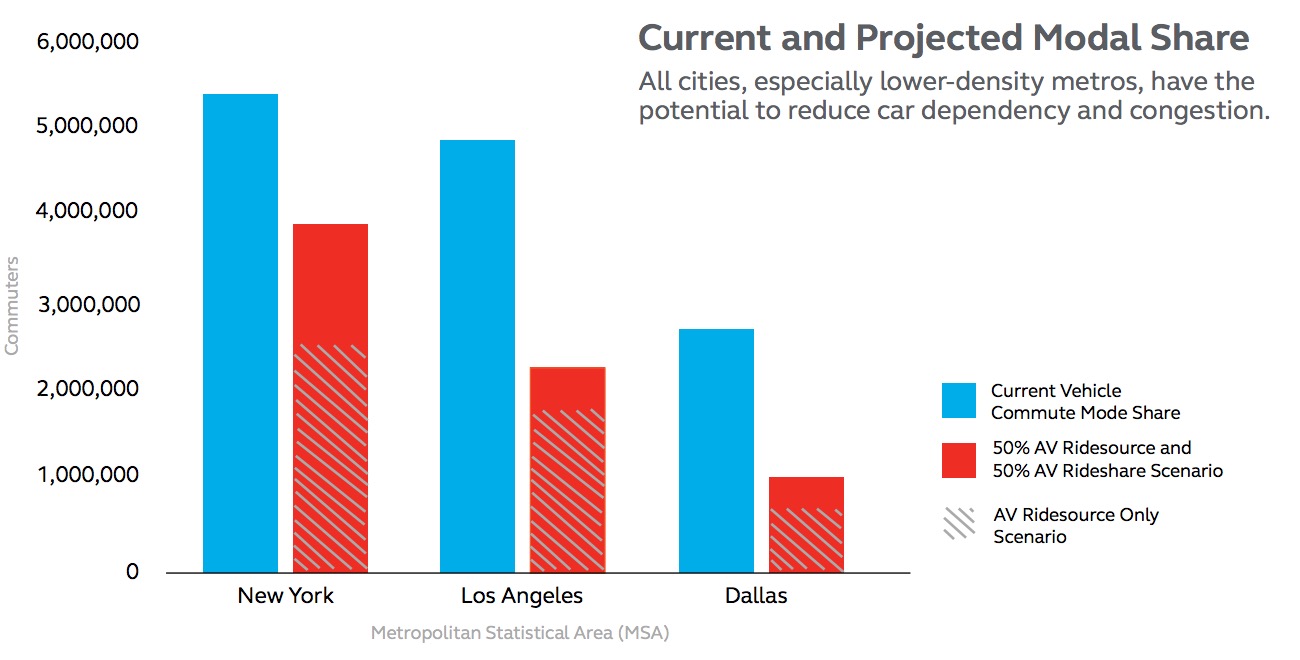ARCADIS DESIGN & CONSULTANCY
HR&A ADVISORS
SAM SCHWARTZ
DRIVERLESS FUTURE was developed by Arcadis, HR&A Advisors and Sam Schwartz to show the significant influence autonomous vehicles and ridesharing can have on our cities. This paper serves as a policy road map for complex issues related to this transportation revolution and its potential impact on equity, public transit, parking, land use and real estate development.
Executive Summary
 The autonomous vehicle has arrived. With automakers and technology firms announcing pilot programs almost daily, it is clear that this technology is quickly becoming a reality on our roads and highways.
The autonomous vehicle has arrived. With automakers and technology firms announcing pilot programs almost daily, it is clear that this technology is quickly becoming a reality on our roads and highways.
The introduction of the autonomous vehicle (AV) and its synergy with ridesourcing services such as Uber, Lyft, Via, Chariot and others, will force cities to confront a host of uncertainties on issues ranging from safety, ethics, insurance, and regulatory requirements to technological necessity, pricing, and the scale of widespread adoption. Cities will soon have to make complex decisions related to infrastructure, urban mobility, land use, and social equity and inclusion as people give up car ownership and take up ridesourcing and, in the near future, ridesourcing run by AVs.
Policymakers have to evaluate how an increasing share of AVs helps or hurts policy objectives, as a growing number of people shift to ridesourcing services and give up traditional public transit. A ridesourcing vehicle, with no driver and no labor costs, could offer extremely low prices, convenient service and be highly disruptive in many cities.
Cities that do nothing face major risks. If proper policies are not in place, transit agencies may lose revenues, professional drivers may be unemployed, cities may be left with large areas of empty parking spaces, and residents and businesses may move in large numbers to suburban and rural areas.
On the other hand, cities that prepare for this technology can reap many benefits, such as the removal of millions of cars from the road, a more sustainable environment, increased mobility, efficiency and social equity, new employment opportunities for drivers and redevelopment of existing parking spaces.
Public policy will play a decisive role in shaping AV technology and guiding its impact on cities, as it did during past technological revolutions involving the railroad, the streetcar, and the automobile. Cities have a window of opportunity to shape how the autonomous vehicle is used and must act now to define policies that minimize risks and maximize the benefits of driverless technology.
Benefits of Advanced Planning:
- Lower vehicle ownership, congestion and vehicle miles traveled
- Equal access to transportation and jobs
- Increased access and mobility, complementary with public transit
- Decreased parking demand
- Growth in vibrant, mixed-use neighborhoods
There is a clear way forward. Cities are already experimenting with new policies, programs and partnerships to address the rise of shared mobility. Based on these experiments, many of which offer a roadmap to AV policy, we have identified six major priorities for policymakers:
1. Leverage technology to enhance mobility.Cities should work with transit agencies and private companies to adopt smartcards, open data and universal apps to allow riders to compare, book and pay for trips that combine buses, trains, bikes and ridesharing vehicles. This will match customers with the most efficient travel choice.
2. Prioritize and modernize public transit. The role of transit will evolve as AVs and shared mobility become widespread. Transit agencies should focus on high-frequency, high-capacity services in dense urban corridors (such as rail, bus rapid transit), provide first and last-mile connections through driverless shuttles, and expand kiss-and-rides/mobility hubs.
3. Implement dynamic pricing. To ensure that AV use supports public objectives and complements public transit, cities should consider a dynamic road pricing plan that varies by origin, destination, number of passengers, congestion, and household income. This can be done through a combination of proven policy tools such as congestion pricing, zone pricing, variable tolls and vehicle miles traveled fee.
4. Plan for mixed-use, car-light neighborhoods. AVs can unlock demand for living and working in mixed-use neighborhoods – whether they are urban or suburban. To shape this demand, cities need to plan for and incentivize mixed-use development, overhaul parking requirements, and reevaluate new public transit projects.
5. Encourage adaptable parking. Fewer cars means fewer parking spaces, especially in city centers. Parking garages need to be built with housing or office conversion in mind and include level floors, higher ceiling heights and centralized ramps. These future-proof garages are already being contemplated in Boston and Nashville.
6. Promote equitable access to new jobs and services. To support disadvantaged populations, cities must encourage public and private operators to provide alternative payment methods, access via dial-a-ride and equitable service coverage. Cities and private partners must also create new employment and training opportunities for drivers and others in legacy occupations.
Download full version (PDF – registration required): Driverless Future
About Arcadis Design & Consultancy
www.arcadis.com
“From climate change to urbanization, we live in an increasingly complex world. Whatever the challenge, we deliver exceptional and sustainable outcomes for our clients. We work collaboratively to create value through built and natural assets that work in harmony with their surroundings – from shopping centers in Shanghai to reduced air pollution in Los Angeles. Arcadis. Improving quality of life.”
About HR&A Advisors
www.hraadvisors.com
HR&A advisors, inc. (HR&A) is an industry-leading consulting firm providing services in real estate, economic development, and program design & implementation.
About Sam Schwartz Engineering
samschwartz.com
Sam Schwartz is a leading traffic and transportation planning and engineering firm known for its ability to solve highly complex traffic and transportation challenges for government, private-sector, not-for-profit and community clients all over the world. Sam Schwartz accomplishes this through technical expertise, creative visioning and consensus building.
Tags: Arcadis, Autonomous Vehicle, AV, HR & A, HR&A, Lyft, Ridesharing, ridesourcing, Sam Schwartz, Sam Schwartz Engineering, Uber, Via







 RSS Feed
RSS Feed
Driverless cars would be helpful as long as there is road space available for them to use. As climate change evolves and the oceans get even warmer, there will be more heavy rainfalls and massive flooding here and there. In such cases driverless cars will be useless for some time – unless there are plenty of elevated guideways available with sufficient capacity for them to use.